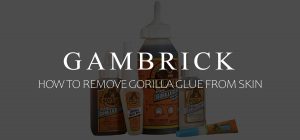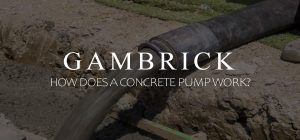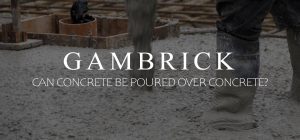Will Quikrete Set In Cold Weather?
Construction is done year round which includes the Winter. And in some regions temperatures always stay cold. When we pour Quikrete in extremely cold weather precautions need to be taken to control its temperature. Quikrete will set in cold weather, but it’s very important to keep its temperature above freezing. Quikrete is just like any other concrete or cement based product. It’s basically just a mix of sand, cement and stone. When water mixes with cement it chemically reacts to form strong bonds that eventually harden like a rock. When temperatures dip below freezing, the water used to mix concrete expands which can destroy the concrete. Quikrete’s temperature must be kept above freezing until it strengthens enough to resist the force of expanding water.
The freezing temperature of water is below 32°F (0°C). So if you’re working with Quikrete in extremely cold temperatures that will be at or below freezing, have a plan in place before mixing, pouring, or placing concrete.
While Quikrete can be mixed and poured during cold weather, there are some things you need to keep in mind which we’ll detail throughout this article.
- First, we’ll discuss what can go wrong when pouring concrete in cold weather.
- Next, we’ll discuss how you can overcome the problems associated with cold weather concreting.
- Finally, we’ll warn you of the most common mistakes we see when pouring concrete in cold weather and provide some useful tips to avoid those mistakes.
Pouring Quikrete and other concrete or cement based products is possible in cold weather as long as you’re prepared and take the right steps throughout the project.
What Temperature Is Too Cold For Quikrete?
There are two main problems you’ll face when pouring Quikrete concrete in cold weather.
1. Quikrete concrete must be prevented from freezing at an early stage. If concrete freezes before it reaches a strength of 500 psi it will deteriorate. Once concrete has achieved a strength of about 500 psi, it can withstand the effects of freezing.
I’ve seen an entire concrete slab reduced to powder because of freezing internal water. It’s very important to keep concrete’s temperature above freezing using a heater and/or a warming blanket.
2. Concrete sets slower when it’s cold but things get very slow when temps dip below 40℉. Below 40℉ the hydration process basically stops which causes concrete to gain strength at a very slow pace.
To help your concrete reach the 500 psi strength it needs to endure cold temperatures, you need to control temperatures. Use a heater and/or warming blankets to keep the concrete above freezing. You should also make sure the ground where you’re pouring the concrete is above freezing. Pouring wet Quikrete onto frozen ground can quickly suck the heat right out of the concrete.
Anything at or below 40℉ is too cold to pour Quikrete without some sort of preparation in place.
Whenever I pour Quikrete in cold weather I have warming blankets, a heater and wind breaks in place to keep the site and concrete warm during the pour and the first week or two as it sets.
Quikrete Fast-Setting Concrete mix is better for cold weather than the standard mix. It contains additives that make it set up faster which is a big help when fighting the cold.
Does Quikrete Cure In Cold Weather?
Quikrete will cure in cold weather if you take steps to prevent it from freezing.
Many of the problems associated with cold weather concrete pouring can be overcome if you know how. Concrete can be manipulated in ways that allow it to set and cure quicker.
- Hot Water: Hot water can be used to mix the concrete which helps when pouring in cold ground.
- Slump: A slump that’s less than 4 inches can reduce bleeding. Since concrete sets slower in the cold, bleeding starts later, lasts longer, and you’ll get more bleed water. Additives can adjust slump levels.
- Accelerators: Accelerators speed up the process which helps in cold weather. Quikrete Fast-Setting Concrete already has accelerators in the mix which is why I like it so much.
Note: Accelerators are not antifreeze agents. They increase the rate of hydration which helps in the cold but they do not prevent freezing.
- Outside Heat: One of the best ways to cure Quikrete in cold weather is by using outside heat. I use tarps and a small heater to warm the area around my concrete pour to above freezing.
- Insulation: Once the concrete is poured you need to keep it above freezing. Insulated warming blankets are the best way to do it.
How Long Does Quikrete Concrete Take To Set In Cold Weather?
Cold temperatures at or below 40℉ can slow and even stop the set and curing process. At 32°F or below, which is freezing, the water used to mix concrete can freeze and expand which destroys the concrete.
Quikrete must be protected during the initial set and curing phase until it reaches about 500 psi. This is strong enough for the concrete to resist the force of expanding water. The length of the protection period must be extended by 50 to 100 percent when temps drop to 40℉ and below.
In most cases, I keep the warming blankets on and tarps up for around 2 weeks just to be on the safe side. There’s no way to know for sure what the psi of your slab is so play it safe and protect your concrete for as long as possible.
Will Quikrete Concrete Cure In 30 Degree Weather?
Concrete sets and cures best between 50 and 60 degrees Fahrenheit. 30 Degrees is too cold for concrete to cure on its own without protection. The water used to mix the concrete will freeze and expand which destroys the concrete.
Concrete can cure at 30 degrees and below, but only if it’s properly protected and kept warm. To make sure your Quikrete concrete maintains a temperature between 55 and 60 degrees Fahrenheit use an enclosure, site heater and warming blankets.
What Happens If Quikrete Concrete Freezes Before It Cures?
Concrete that freezes before it cures strong enough to resist the pressure associated with expanding frozen water will be severely permanently weakened and possibly destroyed.
Early freezing can reduce the strength of the concrete by over 50 percent. And in some cases the entire slab can deteriorate into a powder.
Water is a key ingredient in concrete. When water is mixed with cement, a chemical reaction called hydration occurs. The cement creates strong bonds that hold the sand, stone and cement together. Hydration is what turns sand, stone and cement into a new rock like structure called concrete.
When the water used to mix concrete freezes, it expands. That pressure breaks the bonds created during hydration which weakens or destroys the concrete.
Concrete needs to reach a psi of around 500 before it can endure the force of freezing water without help. Until then, outside heat and insulation should be used to keep the concrete above freezing.
Thing To Avoid When Using Quikrete In Cold Weather
Here are some things you should avoid when pouring Quikrete concrete in cold weather.
1. Don’t Pour Concrete On Frozen Ground
Quikrete concrete should not be poured on ground that’s frozen or covered with ice or snow. Frozen ground will have an immediate and long-term effect on the concrete.
Cold ground sucks heat out of the concrete which reduces its set and cure time. It can also cause uneven curing, cracks and reduces the effect of hot water and/or accelerating admixtures.
Frozen ground may also settle once it thaws which may cause settlement cracks.
Before you pour Quikrete, make sure the ground is warmed to above freezing. I use a combination of tarps or a warming tent and a small site heater.
2. Do Not Allow Concrete To Freeze
The most important thing to remember when using Quikrete in cold weather is to Not let it freeze. This is crucial. If the water used to mix concrete freezes, the internal pressure will destroy the bonds formed during hydration. This can completely destroy the concrete and turn it back into powder.
Water expands when it freezes which causes pressure. When the water used in your concrete mix freezes, it expands, causing damage to the concrete.
If you’re pouring concrete at or below 40°F you need to take steps to keep the concrete above freezing.
Whenever I pour Quikrete in cold weather I use the Fast-Setting mix. It has additives that speed up the concrete’s set and cure time. I also use a warming tent and a site heater to make sure the ground is above freezing. Then I use warming blankets once the concrete is poured. I also keep the tents up for a week or two after the pour along with the blankets to keep temperatures above freezing.
3. Don’t Pour Without Preparation & A Plan
The biggest mistake I see amateur masons make when pouring concrete in cold weather is improper preparation and planning. You need a plan and materials in place to deal with the cold before you pour.
- The best way to protect concrete from the cold is by covering it with insulated warming blankets. Concrete generates heat as it cures. You can lock in this heat with a blanket while you keep the cold air out.
- Warming blankets can also be used the night before a pour to help heat the ground. This is important because you never want to pour concrete on frozen ground.
- Hydronic heating pipes can also be run along the concrete to add warmth. These can be used in addition to warming blankets.
- Enclose the concrete with a temporary site enclosure which keeps the wind out. Then you can heat the area with a small site heater.
Pouring concrete in the cold is more difficult. You not only have the normal concrete issues to deal with but also the temperature to control. But with a good plan and preparation it makes the job much easier.
4. Do Not Use Cold Materials
In addition to ensuring the concrete, ground, and air is warm enough to pour concrete, the forms, tools and other materials used should also be kept above freezing.As a rule, anything that comes in contact with the concrete must be kept above freezing.
Quikrete concrete can be poured during cold weather. It can set and develop enough strength and durability to endure the cold when the proper precautions are taken. A mix that’s properly poured and protected will survive the cold weather when the right precautions are taken.
Summary: Will Quikrete Set In Cold Weather?
Construction is done year round which includes the Winter. And in some regions temperatures always stay cold. When we pour Quikrete in extremely cold weather precautions need to be taken to control its temperature. Quikrete will set in cold weather, but it’s very important to keep its temperature above freezing. Quikrete is just like any other concrete or cement based product. It’s basically just a mix of sand, cement and stone. When water mixes with cement it chemically reacts to form strong bonds that eventually harden like a rock. When temperatures dip below freezing, the water used to mix concrete expands which can destroy the concrete. Quikrete’s temperature must be kept above freezing until it strengthens enough to resist the force of expanding water.
The freezing temperature of water is below 32°F (0°C). So if you’re working with Quikrete in extremely cold temperatures that will be at or below freezing, have a plan in place before mixing, pouring, or placing concrete.
While Quikrete can be mixed and poured during cold weather, there are some things you need to keep in mind which we’ll detail throughout this article.
- First, we’ll discuss what can go wrong when pouring concrete in cold weather.
- Next, we’ll discuss how you can overcome the problems associated with cold weather concreting.
- Finally, we’ll warn you of the most common mistakes we see when pouring concrete in cold weather and provide some useful tips to avoid those mistakes.
Pouring Quikrete and other concrete or cement based products is possible in cold weather as long as you’re prepared and take the right steps throughout the project.
If you have any questions about Quikrete, email any time.





















